2.
GHANA
Management training for exporters
The Ghana Export Promotion Authority has said it will
scale up marketing management training programmes for
exporters to enhance their capacity and ensure they meet
standards in the global market.
Mr Samuel Brew, Head of the Ghana Export School said
that the focus of the capacity building would be to ensure
effective management and supervision, promoting
attitudinal change and management control of operational
costs.
West African business survey suggests confidence still high
West African businesses are doing better than their
counterparts in the west with a steady growth in profits
and revenue being reported along with indications of
strong business confidence levels.
This is the conclusion of the recently released Regus
Business Confidence Index.
In the US and the EU business confidence has fallen
because it looks very likely that the economies in these
countries may slide into a second recession and
expectations for a recovery have slipped to, at best, late
2012.
According to the Regus Business Confidence Index,
¡°West Africa, at 140 points, is 26 points above the global
average, in contrast to the reverse in global confidence in
most other countries¡±.
More West African businesses ¨C mostly in Nigeria, Ghana,
Senegal are reporting higher revenue (65%) and profit
(53%) growth than average, confirming that confidence is
firmly grounded in actual results.
Feeling that the downturn is behind them, 59 percent of
West African businesses believe that recovery is
advancing strongly in their country.¡±
For more on this story please see:
http://www.businessdayonline.com/NG/index.php/econom
ic-watch/28400-west-africa-beats-global-economies-tothe-
post--report
More companies financing tree planting to enhance
their green image
Several non-timber exporting companies in Ghana have
joined the tree planting crusade as part of their perceived
civic responsibilities.
The most recent company to support planting is Cadbury
Kraft Foods which planted a selection of about 600 special
cocoa, grafted mango and Mimosups elengi trees to mark
its annual global initiative ¡®¡®Make a Delicious Difference¡¯¡¯
week.
In Ghana several institutions including telecommunication
companies, schools, churches and various groups have
joined various tree planting exercise to expand the tree
cover outside forest reserves.
These exercises have been well received by among the
communities involved and are supported by the Forestry
Services Division of the Forestry Commission which
provides seedlings.
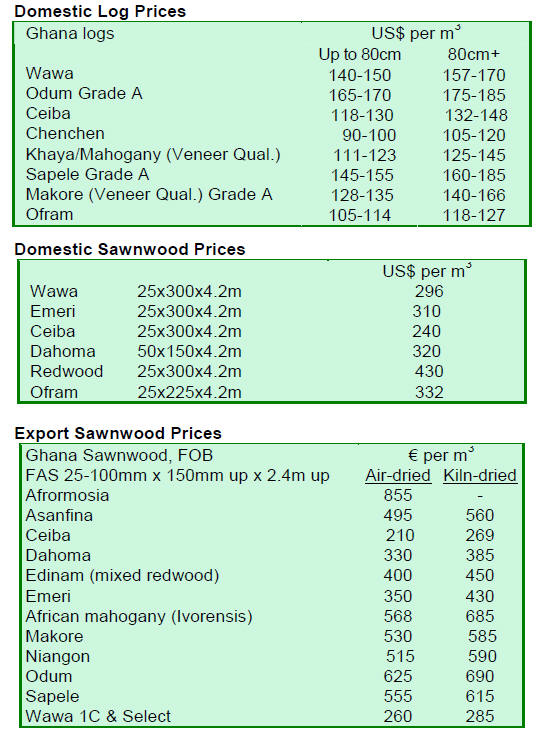
3.
MALAYSIA
Log market to be sustained by Indian imports says
producer
Sarawak based Jaya Tiasa Holdings Bhd. is of the view
that export market prices for logs from Sarawak will
remain firm due to the tight supply situation.
The company suggested that India will continue to be a
major importer of Sarawak logs even though log prices
may increase. Up to the end of July this year log prices
were up around 35% compared to levels in the same
period last year.
This company reportedly produced 598,000 cu.m of logs
in the first eight months of this year. Last year annual log
production by the company was around 940,000 cu.m.
India a major buyer of Malaysian logs
It has been reported that India imported 2.21 million cu.m
of logs in 2010 which is about 56% of Sarawak¡¯s total log
production thereby displacing Japan as the largest importer
of Sarawak logs.
Meanwhile statistics released by the Sarawak Timber
Industry Development Corporation (STIDC) indicate that
India imported 582,000 cu.m or 63% of Sarawak¡¯s total
logs production of 912,000 cu.m in the first half of 2011.
Imports by Taiwan P.o.C ranked second at 128,000 cu.m,
Japan third with 89,000 cu.m, followed by China where
imports were 61,500 cu.m for the same period.
Log production in Sarawak declined by up to 15% to 4.26
million in the first half of 2011 year on year.
This translates to a monthly average production of 710,000
cu.m in the first half of 2011, the lowest monthly average
in two decades.
In addition, analysts commented that one of the main
reasons behind the tight log supply situation in Sarawak is
the unresolved river transportation system problems.
Caution urged as India not immune to global economic shocks
Analysts are urging caution in painting an overly
optimistic picture of India¡¯s continual role as the largest
importer of Sarawak¡¯s logs production.
India is not immune to the effect of the euro-zone debt
crisis and a possible second recession in the US. The
recent depreciation of the Rupee could also impact the
capacity of Indian manufacturers to continue importing at
current levels.
Excise duty, a form of tax collected by the Indian
government on the value of shipments by factories in India
dropped 8% for the first time in 16 months in September
2011, signaling a possible slowdown in the Indian
manufacturing sector.
Indian Purchasing Managers Index for the
manufacturing sector falls
Reinforcing the likelihood of a slow down in the Indian
economy, in September 2011, the HSBC Purchasing
Managers Index (PMI) for the manufacturing sector in
India felled to 50.4 from 52.6 in the August 2011.
Any reading below 50 indicates a contraction in the
manufacturing sector. The HSBC PMI for the Indian
services sector fell to 49.8 in the same month. The services
sector contributes to 60% of economic activities in India.
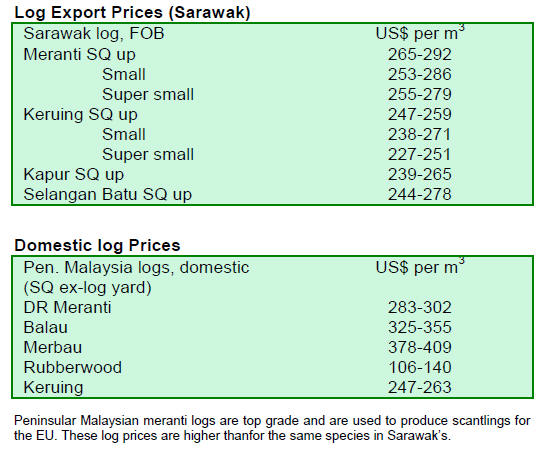
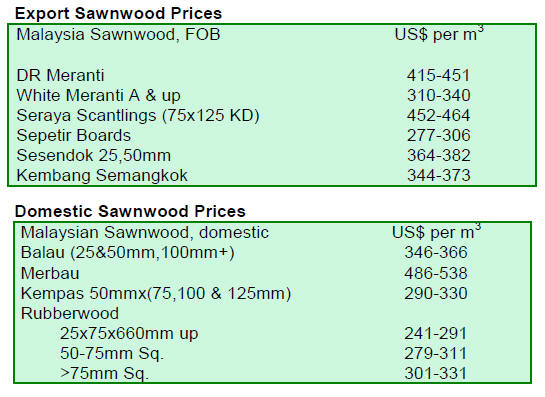
4.
INDONESIA
Investors in oil palm have to wait for
revised
regulations on plantations
Reports indicate that the Indonesian government has
decided to delay the implementation of a regulation
governing industrial forest plantations that would permit
planters, particularly those in the oil palm industry, to
cultivate areas reserved for timber and other sources of
raw material supply for local industries.
The reason cited for the delay is to ensure that the
proposed regulation operates in tandem and consistently
with previous federal decrees. The government has said it
will issue revised regulations.
In classifying oil palm plantations as industrial
forests,
investors in the Indonesian oil palm industry will be able
to obtain land permits from the government to developed
and convert certain forest land into oil palm plantations.
The Forestry Ministry is quoted as saying that the
industrial forest concept has been implemented
successfully for the paper and pulp industry as well a, the
plywood industry so it intend to apply a similar approach
in the oil palm sector.
Analysts point out that only around 30% of Indonesia¡¯s
timber production is now derived from natural forests
whereas 70% is from industrial plantation forests.
Euro-zone and US financial crises bite into
furniture exports
Exports of Indonesian furniture have declined by more
than 30% as the euro-zone and US debt crises bite into
trade. Political unrest in the Middle-East also added to the
toll on the Indonesian furniture industry according to the
Indonesian Furniture Entrepreneurs Association
(Asmindo).
The net value of Indonesian furniture exports for the
first
half of 2011 stood at US$1.15 billion, a decline of 21%
against levels in the first half of 2010 when exports were
valued at US$1.46 billion.
Exports of rattan furniture also declined sharply by
26% to
US$60.32 million in the first half of the year. Exports of
rattan furniture have been sliding ever since the global
economic crisis in 2008.
The depreciation of the US dollar against the
Indonesian
rupiah as a result of both the European and US debt crises
contributed to the decline in the exports of Indonesian
furniture. Competition from other low cost producers like
Vietnam and China compounded the problem further.
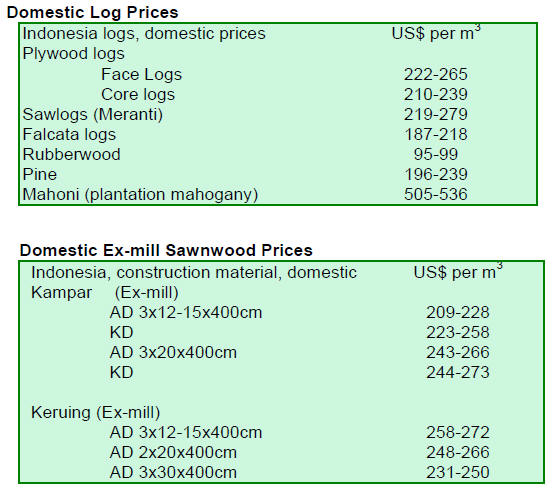
5. MYANMAR
Open tender sale of teak logs for local
industries
About 500 h.tons of SG5, SG6 and SG7 grades of teak
logs were sold on 10th October by open tender to domestic
wood product manufacturers. About 100 h.tons of SG5
were sold at an average price of Euro2084 per h.ton. Some
50 h.tons of SG6 were sold at Euro 1770 per h.ton and
about 350 h.tons of SG7 were sold at Euro 698 per ton.
In comparison to price levels in the September
tender,
where average prices were Euro1554 for SG5, Euro 1382
for SG6 and Euro 975 for SG7, the price levels secured
during the October sales were good. Unlike other open
tender sales, the ¡®raw material special sales¡¯ are only for
logs that are to be locally processed.
Hardwood market showing signs of weakness
The market outlook is said to still be bleak for Pyinkado.
Gurjan (Kanyin) and teak demand is also showing some
strains. This is presumably due to a weaker rupee as India
is the major buyer of logs from Myanmar. Whenever there
is a change in the economy of India it has a direct
influence on Myanmar timber exports.
Teak markets in China, Vietnam and Thailand are also
not
very active but observers say the teak market has always
been resilient as is demand for other hardwoods in a world
hungry for raw materials.
The ¡®cut-less-trees-and-stop-selling-logs¡¯ slogan
is
having an impact
The ¡®cut-less-trees-and-stop-selling-logs¡¯ movement
seems to be gaining momentum as a consequence of the
public outcry over the Ayeyarwady Myitsone Dam issue.
Never before has such an increased awareness in
environmental matters been so prominent in the country,
say local observers.
The Voice Weekly, a local newspaper, reported that
in a
recent interview with the Vice Chairman of FREDA, he
made special mention of the need to not over-harvest the
forest, not to export in log form and to locally produce
more value added wood products to create more jobs and
increased foreign exchange earnings.
Observers believe that upgrading wood processing
technologies and selling more processed products would
eventually assist the country towards reaping optimum
benefits from its forests.
Strengthening exchange rate a serious concern
Since the beginning of this year, the kyat has appreciated
by around 20% against the major currencies and this has
threatened export growth and could undermine the
country¡¯s efforts to revive the economy.
At around 780-800 kyat to the dollar, compared to
more
than 1,000 kyat to the dollar twelve months ago the
exchange rate has become the focus of attention of the
government since the strength of the currency is now
adversely affecting the economy.

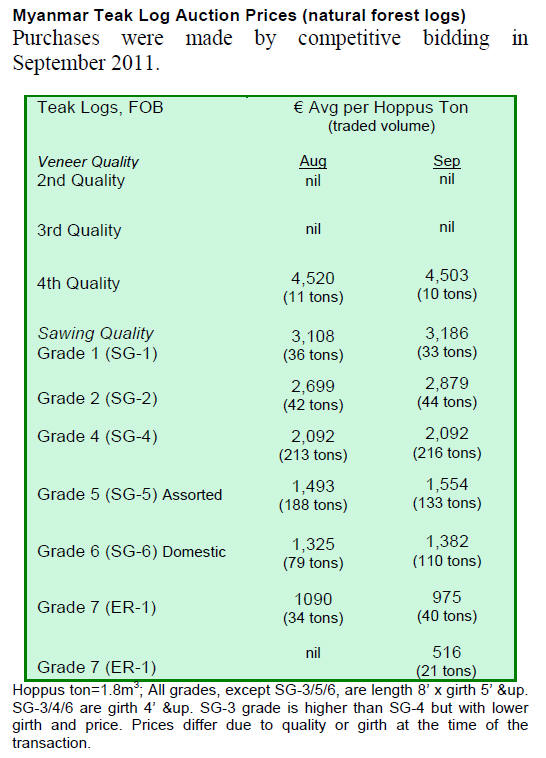
Suspension of the controversial Myitsone dam
project
In a move which surprised observers, Burmese President
Thein Sein has suspended work on the Myitsone dam
project. This came in response to growing public concern
over the project which, say critics, would threaten the
livelihood of those along its banks and would cause
considerable ecological damage.
6.
INDIA
August exports up a robust 44
percent
Data released by the Ministry of Commerce shows that,
despite the economic woes in traditional western markets,
India¡¯s exports maintained their growth in August rising
by 44.2% year on year to US$ 24.3 billion; imports also
grew by 41.8% to US$ 38.4 billion.
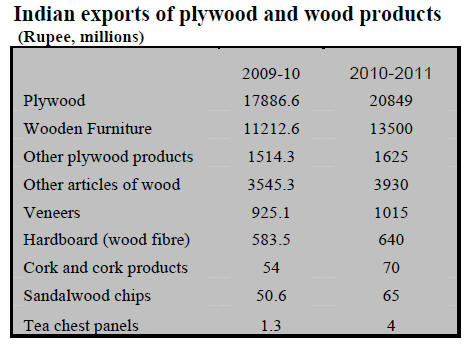
The top three export markets for India¡¯s wood
products are
the USA (23%) Germany (10%) and UK (9%).
The unexpected and sudden fluctuations in the Rupee
and
Dollar exchange rate of around 10% recently is bound to
impact export performance in the coming months. A
weaker Rupee will also make imports more expensive.
Imports of teak logs affected by exchange rate
movements
Serious fluctuations in the Rupee and US Dollar exchange
rate have affected imports of timber and in recent weeks
the 10% rise in import costs of logs due to the depreciation
of the Rupee cannot easily be absorbed by industry say
local observers.
Analysts admit that while there are adequate stocks
of teak
available, shipments have slowed. Demand for substitutes
and alternative timbers such as like Meranti, Kapur,
Merbau and Balau is expected to be sustained because of
the lower cost of these timbers.
Home loan repayments set to surge on interest
rate hikes
In India those with home loans are finding that mortgage
repayments have been rising due to increases in interest
rates and the ending of the period of promotional so-called
¡®teaser loans¡¯ and this is expected slow the demand for
loans and further underming the house building sector.
The Bank of India has been raising rates steadily
over the
past 18 months in order to tackle inflation but this has led
to a higher interest burden for home loan borrowers. The
increase has not yet affected those who took out ¡®teaser¡¯
loans which were introduced in early 2009 to stimulate
house building.
The period of low interest rates on these loans is
coming to
an end and borrowers will soon face a steep increase in
monthly payments. In light of the interest rate increases
and the effect on loan repayments the Indian building
sector expects business to slow significantly.
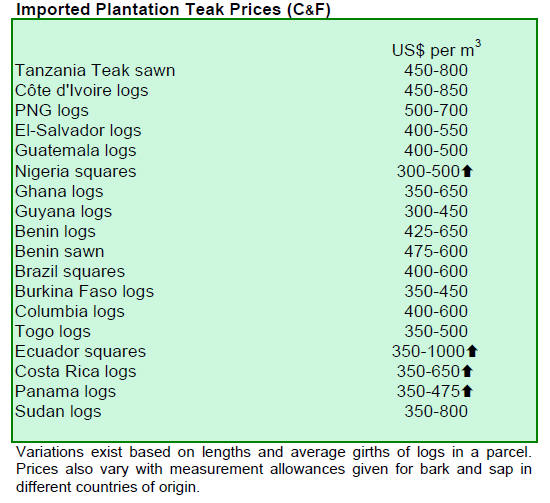
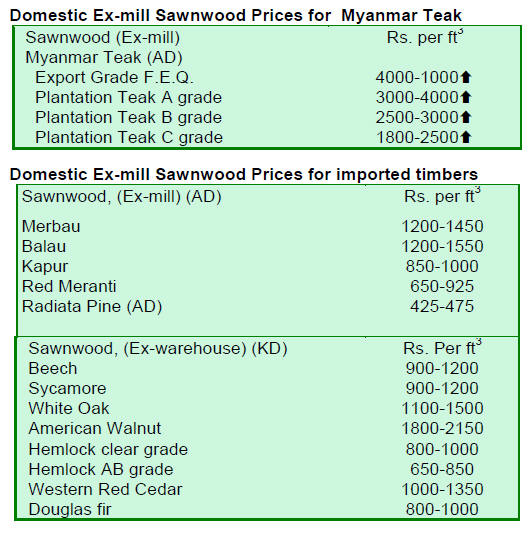
7. BRAZIL
Brazilian exports of tropical sawnwood fall in
first nine
months of the year
According to recent figures released by the Ministry of
Development, Industry and Foreign Trade (MDIC),
Brazil's exports of tropical sawnwood declined during the
first nine months of the year.
Total exports of tropical sawnwood from Brazil in
the first
three quarters of the year amounted to 323,400 cu.m
earning US$ 167.9 million. In the same period last year,
exports were 396,100 cu.m and were worth US$ 191.3
million.
The figures for 2011 represent an 18.4% decline in
terms
of volume and a decline of 12.2% in term of value.
In the year up to September, Brazilian exports of
tropical
sawnwood were mainly directed to Vietnam. The top five
countries importing this product were Vietnam, the
Netherlands, China, France and India.
These five countries accounted for 67% of the
volume and
58% of the value of exports up to September.
Brazil¡¯s tropical plywood exports in decline
Brazil¡¯s Ministry of Development, Industry and Foreign
Trade recently released data showing that Brazil¡¯s exports
of tropical plywood fell 20% in volume and 25% in value
in the first nine months of this year compared to the same
period of last year.
Tropical plywood exports fell from US$ 44.1 million
(78,100 cu.m) last year to US$35.3 million (58,600 cu.m)
this year.
Together, the Amazonian states of Par¨¢, Acre, Mato
Grosso and Rondônia and Mato Grosso do Sul are
responsible for 32% in volume and 34% in value of the
Brazilian exports of tropical plywood, delivering 18,600
cu.m for export and earning US$12.0 million in export
earnings.
Imazon report shows a reduction in unauthorised
forest exploitation in Para
Imazon, (Amazon Institute of People and the
Environment) has just released a Forest Management
Transparency Bulletin for Para State assessing logging in
the State.
According to this report, between August 2009 and
July
2010, out of the 120,512 hectares of forest exploited in the
State of Par¨¢, around 65% (or 78,941 hectares) was not
formally authorised by the Secretary of Environment.
In terms of the area of illegal logging the report
says the
vast majority (84%) occurred on private, unoccupied land
or in areas under dispute. A further 13% occurred in areas
designated as agrarian reform settlements and 3% in
Protected Areas.
Comparing the period August 2008 to July 2009 and
August 2009 to July 2010, there was a 16% reduction in
the unauthorised exploitation.
The study also made an assessment of the
consistency of
information on management plans in the Forest Harvesting
Permits (Autefs) and timber exploitation credits authorised
and issued by Sema from August 2009 to July 2010.
The Imazon report shows that about 90% of the
Forest
Harvesting Permits (Autefs) were in conformity with the
law.
Only 10% contained inconsistencies, for example
logging
authorized for an area larger than the management area;
permits in degraded or cleared areas; permits in areas
already being harvested and traded credits higher than
those allowed by the authority.
Training for wood-processing industry in Mato Grosso
The Wood Producer and Exporter Center of Mato Grosso
(Cipem) is developing a wood industry training
programme in partnership with the Social Service for
Industry (Sesi) and the National Service of Industrial
Learning (Senai).
The main focus of this programme is to improve the
skills
of timber industry workers. The project will deliver
training for up to 2,000 professionals in the Sinop timber
cluster, in Northern Mato Grosso.
In Sinop, there are more than 200 companies
affiliated
with the Wood Industries Union of Northern Mato Grosso.
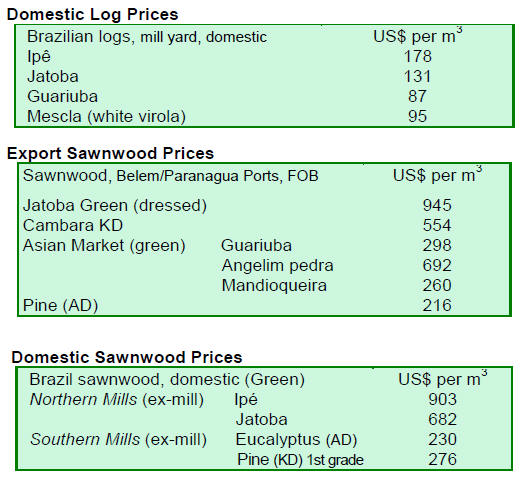
¡¡
8. PERU
Building of new homes and
offices boosts Peru¡¯s
domestic wooden furniture market
According to the consulting firm Maximixe, between
January and May 2011 wooden furniture production in
Peru grew by almost 9%.
Among the factors explaining this dynamism include
increased disposable incomes and the growing number of
new homes and offices coming onto the market.
Wooden furniture imports totaled US$ 23.2 million
between January and May, representing an improvement
of 55% over the same period in 2010.
The imported furniture was reportedly destined for
new
corporate offices in the capital and for new private
apartments. A major component of the imported furniture
was items for the kitchen which more than doubled to US$
1.6 million in the period.
In the first five months of the year, exports of
wooden
furniture amounted to US$ 3.0 million representing an
improvement of 26%, an increase was seen in virtually
every type of wooden furniture. However, a decline in
exports was recoded for upholstered seats with wooden
frames and wooden furniture used in the kitchen.
Adex rejects bill that seeks to suspend logging
concessions
The chairman of the Timber and Wood Industry
Association of Exporters (ADEX) has expressed
opposition to the draft Law No. 308/2011, in which it is
proposed to suspend forest concessions for two years in
order to "stop the deforestation of the forests."
This objection to the proposed law stems from the
assertion that deforestation is not taking place in legal
concessions but in areas where there is shifting agriculture.
The head of ADEX pointed out that sustainable
forest
management in the concessions results in the generation of
jobs, social inclusiveness and environmental sustainability.
He added that forestry operations bring direct and indirect
benefits to around 1.5 million people in Peru.
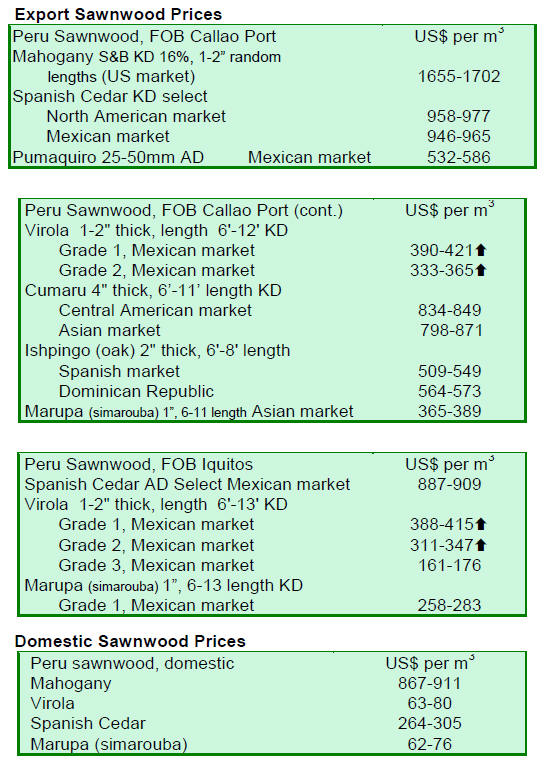
9.
GUYANA
Firm demand is sustaining
favourable price levels for sawnwood
During the period under review only Fair sawmill quality
Greenheart logs were exported. In contrast there was firm
export demand for all qualities of Purpleheart logs but
Standard sawmill quality log prices were lower than for
earlier shipments.
Prices for Fair and Small sawmill quality
Purpleheart logs
remained unchanged whereas prices for Mora logs were
encouraging.
A larger than usual volume of sawnwood exports was
recorded in the period under review. Undressed
Greenheart (select) quality sawnwood prices improved to
US$975 per cubic metre and Undressed Greenheart
(sound) quality sawnwood prices were US$ 847 per cubic
metre merchantable quality prices were US$500 per cubic
metre.
For Undressed Purpleheart (select) sawnwood, prices
remained unchanged during this period as did prices for
Undressed Mora sawnwood.
Dressed Greenheart prices remained firm at levels
seen a
month ago while Dressed Purpleheart sawnwood prices
fell from US$1,060 to US 912 per cubic metre.
Dressed Red Cedar (Cedro) sawnwood was sold on the
export market for US 1,272 per cubic metre. Similarly
Dressed Locust (Jatoba, Courbaril) also fetched good
prices at US$1,166 per cubic metre on the export market.
Encouraging product diversification to boost
domestic manufacturing
The Forest Products Development and Marketing Council
of Guyana Inc. (FPDMC) is working to help boost the
value added industry by encouraging product development
for the domestic wood processing sector.
This in turn is expected to create high ¨Cend niche
markets
for these products locally. This initiative is aimed at
encouraging the value added industry to expand the range
of products marketed.
Product profiles are being prepared by the FPDMC
with
the aim of steering entrepreneurs to additional added value
product lines and also to build on existing product lines
that can be fostered and expanded.
This is seen as a cost effective venture and the products
produced can be used by domestic consumers as there is at
present a housing boom taking place in Guyana. The aim
is to keep the products affordable and is made out of
sustainable harvested lesser known species of woods.
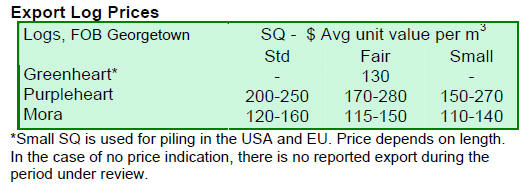
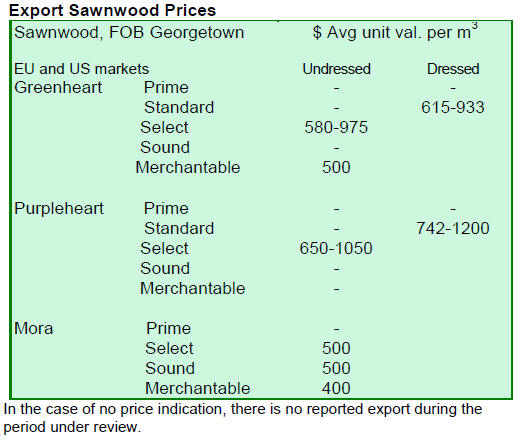
Related News: